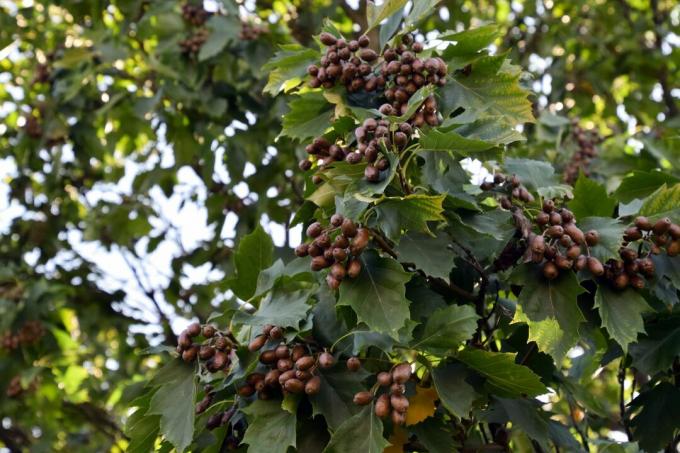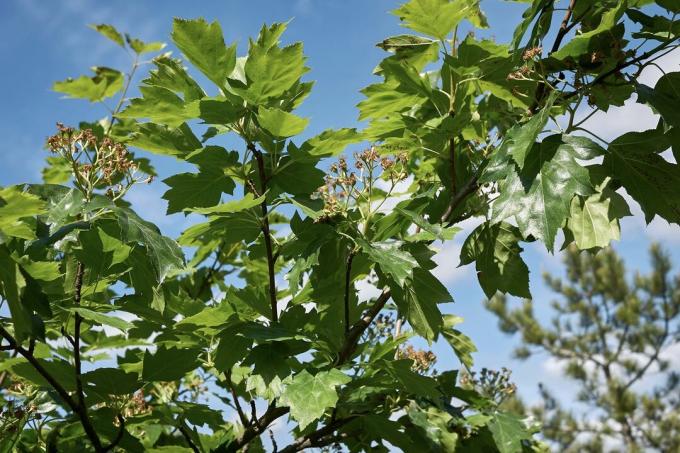The service tree is a native tree species that is rarely found in forests. With us you can find out everything about the service tree, its properties and planting in your own garden.

Despite its valuable wood and edible fruits, the service tree is hardly known and is rarely planted. We will introduce you to the local tree species and give you tips on planting, caring for and using the service tree.
"Contents"
- Wild service tree: origin and characteristics
- Planting service tree: location, timing and procedure
- Care of the service tree: cutting, watering and Co.
- Propagate service tree
- Harvesting and using Sorbus torminalis
Wild service tree: origin and characteristics
The service tree (Sorbus torminalis) is also known as Atlas berries, Adlitzberries, Wilder Sperberbaum, Schweizer Pirnbaum or Ruhrbirne, because their fruits were used against dysentery in the past.
It is closely related to the mountain ash or rowanberry (
The service tree grows as a medium-sized tree up to a height of 10 to 25 m and its crown becomes up to 12 m wide with age. On shallow soils, on the other hand, it develops into a large shrub or a small tree around 5 to 10 m high. At a young age it is extremely fast-growing and increases in shoot length by 40 to 60 cm per year. The coveted wood of the service tree is extremely hard, tough and colored from white-yellow to reddish. It is often sold under the name "pear tree" at the highest prices and is used for flute making and small furniture as well as for woodturning and as veneer. The buds of the service tree in winter are egg-shaped, 7 to 9 mm long and green with a brown border. The maple-like, rounded, lobed leaves of the service tree are colored matt gray-green on the underside. In autumn the tree turns a splendid yellow-orange to red-brown.

The white, bee-friendly flowers of the service tree are grouped together in large panicles and bloom from May to June. They are reminiscent of apple blossoms, but give off a rather unpleasant odor. The edible fruits that develop are egg-shaped and about 1.5 cm long. From October the wild service berries, which are doughy-soft and leather-brown after the effects of frost, feed on birds and mammals. The service tree is a poorly competitive pioneer tree that needs sufficient light to develop. Therefore it is hardly to be found in our densely planted and rather dark forests.
tip: In contrast to rowan berries, service berries can be eaten raw. The leaves of the rowanberry are also lobed, the fruits are colored orange-red when ripe and can be clearly distinguished from the service tree.
Planting service tree: location, timing and procedure
The service tree is a warmth-loving tree that should only be planted alone in larger gardens. The ideal location for wild service berries is on dry to fresh, nutrient-rich and calcareous, well-drained soil in full sun or partial shade. The pH value can have a value between 4.5 and 8, i.e. it can be acidic to slightly alkaline. The service tree dies or hardly grows on wet soils or pure sand.
The best time to plant the trees is between October and late November, when they are dormant and have lost most of their leaves. High service tree trunks, half-trunks and trees that are still just a few years old are offered by most tree nurseries. As a tree in a stand-alone position, there should be a 4 to 5 meter distance to other plants on all sides. Dig a large planting hole at the future location, which is about 1.5 times the size of the root ball of the service tree. For an optimal start of growth, add some primarily organic long-term fertilizer, such as ours, to the excavated soil Plantura organic universal fertilizer, add and mix both. The nutrients contained in the fertilizer granulate are released by soil organisms over a period of several months. Only then are they available for plant roots and there is no risk of nutrients being washed out.
Now lift the service tree into the planting hole and take care not to set the root ball too deep. This is particularly important with grafted plants, the grafting point must be well above the ground. Now fill the planting hole with the soil-fertilizer mixture again and solidify the substrate around the plant a little. If the plants are already larger, two stakes should be driven into the ground across the direction of the wind and the tree should be secured with a stable tree connection. The tree must be restricted in its movement so that young fine roots do not tear when the trunk is moved by the wind. In wind-exposed locations there is also the risk that the tree will grow crooked. Finally, form a watering rim out of earth and then water vigorously.
tip: The service tree is self-incompatible, so it cannot fertilize itself. A second service tree in the garden as a pollinator increases the yield. The two trees cannot be clones. It is best to choose two different varieties or two plants from different nurseries or wild stocks.

Summary: plant service tree
- Soil: dry to fresh, nutritious and calcareous, well-drained
- Location: sun or partial shade
- Planting time: October - late November
- Planting distance: 4 - 5 meters
- Tie a tree for stability
Care of the service tree: cutting, watering and Co.
The service tree is easy to care for and hardly needs any attention. Freshly planted trees can be watered for support in critically dry summers. The service tree is astonishingly drought-tolerant; adult trees hardly ever need water.
Cutting is not absolutely necessary with service berries, but every now and then diseased and dead branches should be removed and the crown should be thinned out if necessary.
Occasionally, aphid populations, fruit tree sapwood beetles (Scolytus rugulosus) and some fruit tree moths such as the plum web moth (Yponomeuta padella) the service tree. However, vole bites on the roots of young trees are much more dangerous - a wire basket can help here when planting. Scab (Venturia inaequalis) and Armillaria- Fungal infestation is one of the few diseases of the service tree and can cause the death of young or otherwise weakened trees.
Service berries are completely hardy, their leaves are only slightly sensitive to early frost in October. They can fall off prematurely - but this does not jeopardize new growth in the next year.

Propagate service tree
Service berries can be propagated generatively via seeds or vegetatively via root shoots or grafting.
Good results with seed propagation can be achieved simply by sowing the seeds in October after harvest and you let nature break the dormancy - but animals like to get the seeds in winter eaten.
Like most native tree species, serviceberry seeds also have a dormancy. The fruits contain numerous kernels that require a longer cold stimulus to germinate, i.e. they have to be stratified. Precise instructions for the successful sowing of Cold germs in every season you will find in our special article. Service berries, propagated via seeds, only bloom and bear fruit after 15 to 20 years.
For asexual, vegetative reproduction, the service tree forms many root shoots after a certain age, which can be cut off and transplanted. An alternative is the grafting of young service tree shoots on rootstock from Hawthorn (Crataegus) or pears (Pyurs). For this purpose, leafless vines are cut in late autumn or winter and grafted in early spring between the end of February and mid-March. In our article "Refine apple tree“We present various methods that are also suitable for grafting service berries. Refined service berries fruit immediately, provided that the noble rice comes from an adult service tree that is already flowering itself.

Harvesting and using Sorbus torminalis
The edible fruits of the service tree can only be really enjoyed after the first frost or a longer storage period. Only then do the numerous fruits become soft and doughy and develop their apple sauce-like aroma. The harvest time for service berries therefore begins in October or November and ends in December. The fruits are cut off as a whole panicle and then plucked individually.
The taste is reminiscent of that of the Medlar (Mespilus germanica) and numerous specialties such as wild service jam, compote and juice can be made. Liqueur, French brandy "Eau d’Alizer" and the service berries schnapps, the "Adlitzbeerwasser", are among the most valuable fine brandies made from wild fruit, for which around 150 euros per liter are paid. Dried service berries are real delicacies because they have an almond and marzipan-like aroma.
Another, rare relative of rowan and service tree is the Service tree (Sorbus domestica). In our profile you can find out everything about this valuable, rare fruit tree.



